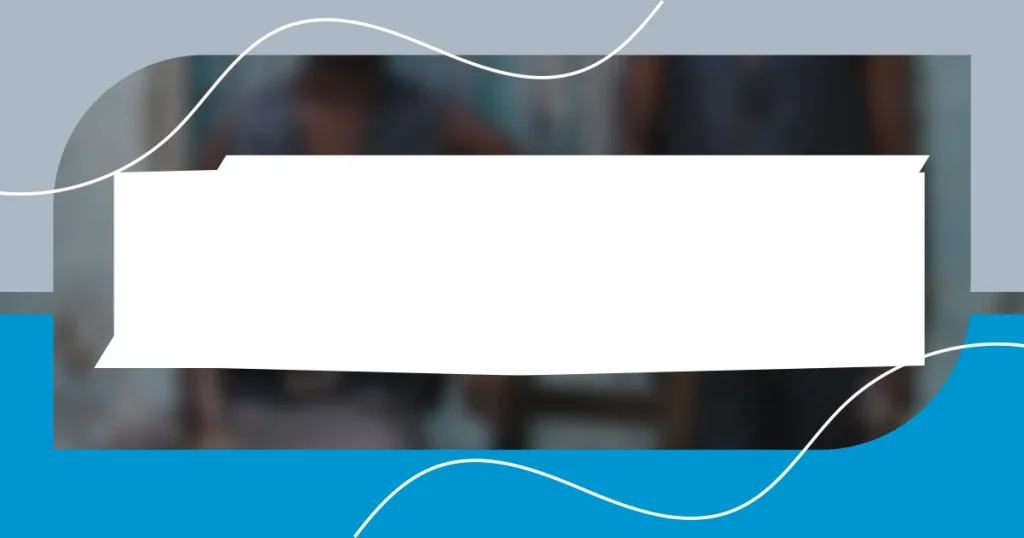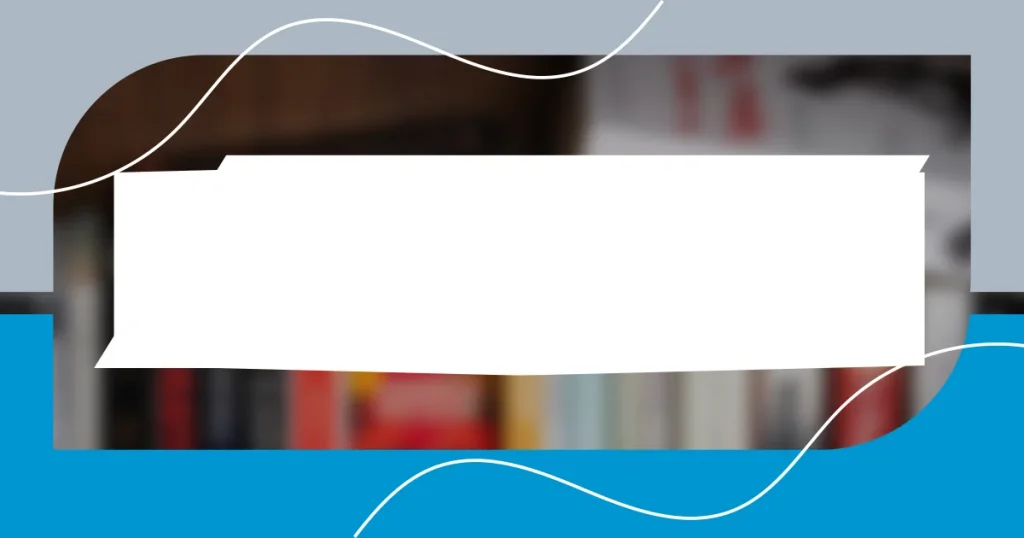Key takeaways:
- Understanding women’s narratives involves recognizing the intersection of identity, culture, and societal expectations, promoting empathy and challenging stereotypes.
- Researching relevant literature and choosing appropriate analytical methods (qualitative, quantitative, mixed) enhance the comprehension of women’s experiences and reveal systemic issues.
- Effectively presenting findings through storytelling and visuals engages audiences, emphasizing the emotional depth behind individual narratives and fostering personal connections with the content.

Understanding women’s narratives
Understanding women’s narratives requires a deep appreciation of the diverse experiences that shape their stories. I often find myself reflecting on the moments when women opened up about their struggles—whether it was a friend sharing her journey through career challenges or a stranger recounting her fight against societal expectations. Isn’t it fascinating how these personal tales reflect broader societal issues?
I remember hearing a powerful narrative from a woman who had overcome significant obstacles to thrive in her field. Her story resonated with me, not just for its triumph but for the raw emotions that laid bare the vulnerabilities she faced along the way. How often do we let ourselves truly absorb the weight of someone else’s experiences? There’s a richness in connecting with these narratives that deepens our understanding of resilience and strength.
I’ve learned that women’s stories are not just to be heard but also understood in context. Each narrative offers a glimpse into the intersection of identity, culture, and societal expectations. It raises vital questions about our perceptions: are we willing to look beyond stereotypes and truly listen? Engaging actively with these voices invites us to explore empathy more profoundly, challenging us to reconsider our views and assumptions.

Researching relevant literature
Researching relevant literature is an essential step in analyzing women’s narratives. I often find that diving into existing studies and theories offers a roadmap for understanding the complexities of their experiences. I remember spending hours in my favorite library corner, surrounded by stacks of books and articles, piecing together how different authors approached this topic. It was almost like a quiet conversation with thinkers who came before me, shaping my perspective on gender and society.
When I began my research, I noted several key areas of focus:
– Intersectionality: How various social identities intersect to shape experiences.
– Storytelling techniques: The methods used by women to convey their narratives.
– Historical context: Understanding how past events influence contemporary narratives.
– Emotional resonance: The ways emotions are expressed and perceived in their stories.
– Representation in media: Exploring how women’s voices are portrayed in literature and other media.
Each of these aspects illuminated different layers of women’s narratives, enriching my overall analysis and personal connection to the stories shared with me. Exploring literature was not just an academic exercise; it was a journey that deepened my empathy and understanding of the powerful themes within women’s lives.

Choosing appropriate analytical methods
Choosing the right analytical methods is integral to effectively dissecting women’s narratives. I’ve often found that qualitative methods, such as thematic analysis, provide a rich lens through which to view individual experiences. By categorizing recurring themes, I gain insight into the underlying issues that resonate with many women’s stories. It reminds me of the time I was sifting through several personal accounts, trying to identify patterns of resilience—each theme opened a door to a deeper understanding of shared struggles.
Quantitative approaches can also offer valuable perspectives, especially when examining larger data sets. For example, employing surveys can help reveal trends in women’s experiences across different demographics. Can you imagine uncovering the stark differences in challenges faced by women in various cultural contexts? I once analyzed survey data that highlighted significant disparities in career advancement opportunities for women from different backgrounds, which shed light on systemic barriers that require urgent attention.
Ultimately, the choice of analytical method depends on the narratives being explored. Striking the right balance between qualitative and quantitative approaches can enhance our comprehension of women’s experiences. I remember sitting with a diverse group of women, hearing their stories firsthand while simultaneously referencing research findings; it was a powerful blend that enriched both the discussion and my understanding of their realities. Such experiences compel me to think critically about how we analyze these voices, as every choice of method reflects our commitment to honoring their truths.
| Analytical Method | Description |
|---|---|
| Qualitative Analysis | Focuses on themes and meanings to understand personal experiences. |
| Quantitative Analysis | Uses statistical methods to identify trends across larger groups. |
| Mixed Methods | Combines qualitative and quantitative to deepen understanding. |

Collecting women’s personal stories
Collecting women’s personal stories is both a privilege and an eye-opening adventure. I remember the first time I sat down for a series of interviews; there was an unsteady thrill in the air, as if I was about to uncover hidden treasures. Every woman brought a unique narrative to the table, and with each story, my appreciation for their resilience grew. Engaging with their experiences felt like holding a mirror to societal challenges, wouldn’t you agree?
As I started recording their tales, I noticed how powerful the act of storytelling can be. One woman spoke candidly about her struggles with self-identity after moving to a new country. The emotion in her voice was palpable, and it reminded me that sharing these stories not only validates personal experiences but also fosters a sense of community. I realized that these narratives hold the potential to inspire change and encourage others to share their own journeys.
Gathering these narratives requires sensitivity and trust; I found that creating a safe space was crucial. I often asked open-ended questions that allowed the women to express their feelings freely, which deepened our connection. This process taught me that every story is unique yet intertwined with universal themes. As I listened attentively, I felt honored to be a part of their narratives, and it drove home the point that every voice matters. How often do we overlook the quiet strength found in these shared experiences?

Identifying common themes
When I dive into women’s narratives, identifying common themes becomes an enlightening journey. I still recall a workshop where we mapped out shared experiences on a whiteboard, revealing themes of empowerment, vulnerability, and resilience. It was eye-opening to see how, despite vastly different backgrounds, many women echoed one another’s struggles and triumphs. Have you ever witnessed such collective insight? The emotional weight in the room was palpable as we connected those threads.
In my research, I’ve often found that recurring themes can serve as a beacon, guiding deeper analysis. For example, in one narrative, a woman described how motherhood transformed her identity. Finding similar sentiments scattered across various interviews was like piecing together a puzzle—each perspective enriching the overall picture of women’s multifaceted experiences. Isn’t it fascinating how individual stories can converge to highlight larger societal issues? It reminds me that while each voice is unique, they can communicate universal emotions and truths.
As I sift through these narratives, the commonalities often prompt me to reflect on my own journey. Once, while listening to a participant discuss her struggle with work-life balance, it struck me how her feelings mirrored my own past challenges. It’s moments like these that reveal themes of connection and understanding—the very essence of our shared humanity. I believe that recognizing these threads helps me not only analyze the narratives but also appreciate the profound impact of women sharing their stories. How might we further explore these connections to elevate the voices often overlooked?

Presenting findings effectively
Effective presentation of findings is about transforming data into a compelling narrative. I remember preparing for my first presentation; I was nervous about how to convey the findings without overwhelming my audience. I learned that visuals, like infographics or graphs, can simplify complex data, making it more digestible. Have you ever noticed how a good visual can transform your understanding of a topic? I certainly have.
As I structured my findings, I focused on storytelling. Each theme uncovered during my analysis deserved its own spotlight. I recall presenting a particularly poignant story about resilience, where the room fell silent as I painted the picture of a woman overcoming adversity. I felt that silence was powerful—it meant the audience was truly engaged. It taught me that sharing these stories not only highlights individual journeys but also underscores collective issues that resonate with many.
Feedback also plays a crucial role in presenting findings effectively. After my presentations, I often sought out reactions to gauge what resonated with listeners. One comment after a session stuck with me; someone said, “Your words made me reflect on my own experiences.” Moments like that affirm the importance of connecting findings with emotions. It reminds me that while numbers tell part of the story, the real impact comes from sharing the human element behind the data. How do you ensure that your findings connect with your audience on a personal level?
















